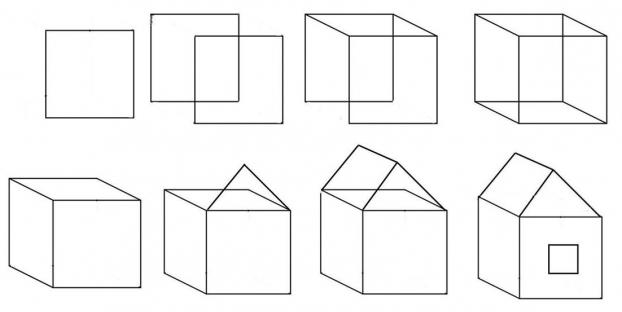Very often the question arises: "How to draw a house?" The easiest way that kids and their parents use is a planar image. That is, drawing a square or rectangle, a front wall facing the observer, above it - a triangle-roof, windows, pipes. But this is the so-called "children's option." And how to draw a house so that it looks more real? Here you should get acquainted with several scientific concepts.
How to draw a house in isometric view?
For the first time we come across this method in the study of trigonometry, as well as in drawing lessons. Drawing a cube at trigonometry lessons, we get a visually almost real view of it in a three-dimensional image. Moreover, all sides of it retain the same size, and the front - even has right angles. The method of depicting objects in isometric projection is used in mechanical engineering when plotting parts on drawings, in computer-aided design systems and in computer games.

And since you can draw a house in isometric view using the cube drawing algorithm, you need to start with a square or a rectangle: it all depends on what the front wall of the depicted object is. Next, draw a back wall identical to the front, placing its base slightly above the front wall and moving it to the right or left. The third step is to connect the corners of squares or rectangles. Now you should remove the extra auxiliary lines with an eraser. The roof should also be made in isometric view. This will not be difficult for those who are already faced with an algorithm of such constructions. Thus, the question of how to draw a house with a pencil can be considered resolved. But still, something in the resulting figure is not quite so!
How to draw a house?
The answer to this question was found in the fifteenth century by an architect from Italy Brunelleschi. It was he who drew attention to the fact that removed objects seemed to visually decrease. If we compare a tree standing a meter from the observer with the same tree at a distance of twenty meters, the difference will be very noticeable. And the rails? Here they are under our feet, seemingly parallel to each other. But if you look into the distance, you can see that the distance between them all decreases and decreases. In the end, there is a mystical transformation: parallel rails "flow" into one point! This point is called a “vanishing point”: all parallel lines are connected in it . Having determined the depth of the projection, that is, the location of the vanishing point of the lines relative to the image object, the artist builds a model of the future drawing. An interesting fact is that the vanishing point can be located far beyond the canvas on which the painting is planned. Then they draw (possibly mentally) all the lines. They should converge at this point. Thus, the back wall of the house is shorter than the front. But the image comes out more realistic than with the drawing method, based on isometric projection.